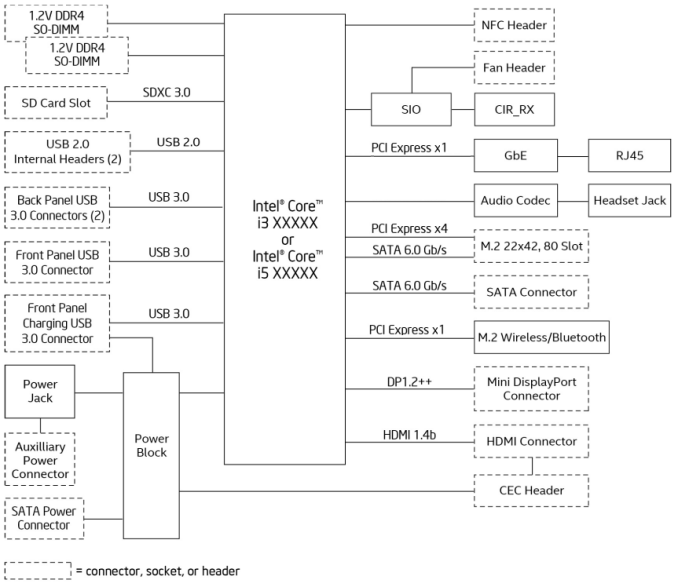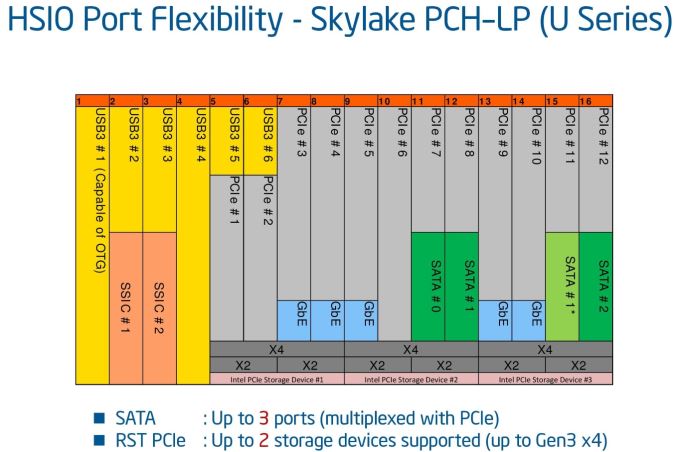Choosing the Right SSD for a Skylake-U System
by Ganesh T S on May 9, 2016 8:00 AM EST
Our Skylake NUC review had a brief section on the performance of the storage subsystem. The comments section raised a few questions about the inability of SSDs such as the Samsung SSD 950 PRO to achieve maximum performance in the NUC. After some discussion with Intel, we discovered some interesting aspects in the design of Skylake-U systems that have a bearing on the performance of some M.2 PCIe SSDs. These can affect the consumer's choice of SSDs for a Skylake-U system - be it a NUC or an user-upgradeable notebook.
Background
Intel has a wide range of CPUs based on the Skylake microarchitecture. These target a variety of markets ranging from tablets / 2-in-1s and Compute Sticks to the traditional tower desktops. The same microarchitecture is able to serve different markets because of the scalable nature of the TDP / power envelop (from 4.5W to 91W).
While the high-performance H-, S- and K- CPUs need a separate Intel 100 Series platform controller hub (Sunrise Point PCH), the Skylake-U and Skylake-Y are Multi-Chip Packages (MCP) that have the Sunrise Point-LP PCH die integrated with the CPU in a single package.
The communication between the CPU and the PCH in the H-,S- and K- systems is via the Direct Media Interface (DMI 3.0),a proprietary link protocol developed by Intel. Skylake-U/-Y series processors, on the other hand, have an On Package DMI interconnect interface termed as OPI. Unlike DMI 3.0, the OPI in Skylake-U/-Y can be configured to meet the desired power or performance needs of a mobile system design. The following table summarizes the differences between DMI and the two configurable OPI options in Skylake systems.
| Skylake CPU - PCH(-LP) Communication Link Characteristics | |||
| Aspect | DMI 3.0 | OPI GT2 | OPI GT4 |
| Applicable Systems | Skylake-H/-S/-K | Skylake-U/-Y | |
| Link Width | x4 | x8 | |
| Transfer Rate per Lane | 8 GT/s | 2 GT/s | 4 GT/s |
| Max. Theoretical Bandwidth | 3.94 GBps | 2 GBps | 4 GBps |
For all practical purposes, DMI 3.0 and PCIe 3.0 are equivalent, and this is important when a PCIe 3.0 x4 SSD is connected to the a Skylake-H/-S/-K system using PCIe lanes from the PCH. Any other peripheral communicating with the CPU at the same time as the PCIe SSD would end up creating a bottleneck at the CPU-PCH link. On the other hand, Skylake-U/-Y systems that have a PCIe 3.0 x4 SSD connected to the Sunrise Point-LP PCIe lanes will be directly impacted by the configuration of the OPI. The GT4 configuration should have enough bandwidth to get full performance from a PCIe 3.0 x4 SSD, but a GT2 configuration could end up throttling such a device.
Analyzing the Skylake NUC6i5SYK Storage Subsystem
In order to determine whether the Sylake NUC6i5SYK is affected by the OPI capabilities, it is essential to understand the board design and the way each of the peripheral ports connect to the CPU.
The above block diagram should be considered in conjunction with the Skylake PCH-LP high-speed I/O (HSIO) configuration options depicted below. One of the x4 links multiplexed with a SATA lane is used for the M.2 22x42,80 SSD slot. One of the PCIe lanes that gets multiplexed with GbE is connected to the Intel I-219V Ethernet Adapter., and yet another PCIe lane is used for the WLAN adapter. The important aspect to note here is that any M.2 SSD can have full PCIe 3.0 x4 connectivity to the Sunrise Point-LP PCH.
Intel's current technical documentation (PDF) for the Skylake NUC board mentions that the maximum possible performance for any M.2 SSD is around 1600 MBps. The Samsung SSD 950 PRO and SM951 PCIe 3.0 x4 NVMe SSDs claim performance numbers in excess of 2000 MBps. This obviously means that there is a bottleneck between the Skylake CPU and the Sunrise Point-LP.
Intel's Skylake-U/-Y reference designs are optimized for lower power and default the OPI to GT2 rates. In the development of the NUC6i5SY product family, the Intel team utilized the reference designs and default settings for the OPI and GT2 rates. Therefore, PCIe 3.0 x4 SSDs connected to the M.2 port of the NUC6i5SYK (BIOS v0042) are effectively limited to PCIe 2.0 x4 rates. This throttling makes sense for battery-operated devices like 2-in-1s, but, not so much for UCFF desktops like the NUCs.
After we brought this to Intel's attention, the development team decided to complete the necessary changes and validation to support the maximum PCIe 3.0 performance. Intel sent over a development BIOS (v1142) that turned on the higher performance OPI GT4 rate. This BIOS is scheduled to be made public before the end of May 2016 (after completion of internal validation).
Evaluating the NUC6i5SYK Storage Subsystem
The rest of this review deals with two major aspects - a quantitative measurement of the effectiveness of different types of SSDs in the Skylake NUC, and an evaluation of the improvements resulting from ramping up the OPI to GT4 rates (i.e, a comparison of the performance using BIOS v0042 and BIOS v1142). In order to do this, we processed various benchmarks while keeping everything other than the M.2 SSD and the BIOS version constant.
| Intel NUC6i5SYK Benchmarked Configuration | |
| Processor | Intel Core i5-6260U Skylake, 2C/4T, 1.8 GHz (Turbo to 2.9 GHz), 14nm, 4MB L2, 15W TDP |
| Memory | Corsair CMSX16GX4M2A2400C16 DDR4 15-15-15-35 @ 2133 MHz 2x8 GB |
| Graphics | Intel Iris Graphics 540 (Skylake-U GT3e) |
| Disk Drive(s) | Various M.2 SSDs |
| Operating System | Windows 10 Pro x64 |
| Full Specifications | Intel NUC6i5SYK Specifications |
The various benchmarks presented in the next few sections were all processed with the M.2 SSD as the primary drive. The drive was initialized with two partitions. The primary OS partition was set to be 120GB in size, while the remaining space was allocated to the secondary partition. Both of the partitions were formatted in NTFS with default settings.
In the next section, we will first take a look at the specifications of the four M.2 SSDs that were evaluated in the NUC6i5SYK, along with CrystalDiskMark scores for each in both the BIOS versions. Following this, we move on to real-world benchmarks - SYSmark 2014, PCMark 8 Storage Bench and a slightly tweaked AnandTech DAS Suite. Prior to our concluding remarks, we take a look at a few miscellaneous aspects - power consumption, thermal characteristics and pricing.













40 Comments
View All Comments
Kristian Vättö - Monday, May 9, 2016 - link
I just checked all drives that I benchmarked while at AT. The most was 37MB/s (4KB random read QD1), with most SATA drives hovering between 25-30MB/s. The 256GB SM951-NVMe, on the other hand, did 52MB/s.vladx - Monday, May 9, 2016 - link
Yeah, but paying double for that much is definitely not worth it.Haul22 - Tuesday, May 10, 2016 - link
While I believe you that the fastest SATA drives that you tested maxed at 30 MBps in random read tests, what makes you think that this is a limitation/bottleneck of the SATA bus rather than the components inside of the SSD (the controller, the NAND flash chips, the number of NAND flash chips, etc)? I do not understand how Ganesh can make statements like "The bandwidth numbers, on the other hand, show that there is a lot to gain by going from SATA to PCIe, and from AHCI to NVMe, and from PCIe 2.0 to PCIe 3.0. However, the gains obtained in each of these upgrades becomes progressively smaller." While I find your benchmark of the 4 SSDs to be very useful, I don't see how you can draw these kinds of conclusions about SATA vs PCIe or AHCI vs NVMe based on your tests.Also, I don't understand where these 50 MBps and 30 MBps numbers are coming from. Your 850 Pro review from 2014 at http://www.anandtech.com/show/8216/samsung-ssd-850... shows numbers way higher than 30 or 50. Sorry if I'm missing something obvious.
Haul22 - Tuesday, May 10, 2016 - link
Okay I just re-read the article and think the 50 MBps number is coming from the CrystalDiskMark tests. I think these numbers are very low compared to what other tools will produce, even at QD=1. Regardless, I still don't see how we can draw conclusions about SATA vs PCIe or AHCI vs NVMe based on these results.Visual - Thursday, May 12, 2016 - link
I'm totally confused... what are these 30-50MB/s you guys are talking about? Even a crappy USB3 magnetic drive easily does 150MB/s, internal ssds have been pushing the 300MB/s limits of SATA 2 and even 600MB/s of SATA 3 for years now. And before you jump on me with the "random vs sequential" excuse, aren't ssds supposed to make that distinction irrelevant?TheinsanegamerN - Monday, May 9, 2016 - link
The premium is pretty high. A 256GB 950 pro m.2 is $189, a 1TB sata ssd is $209. That is a pretty big difference.Heck, last year I got a 512GB SSD for less than $189.
dzezik - Thursday, May 12, 2016 - link
this is limited by very old sandforce controller not designed for MLC but for SLCvladx - Monday, May 9, 2016 - link
I don't know why would you buy a PCI SSD unless you do a lot video work where you really need the best seq speed. For others , even gamers it's 99% waste of money.jasonelmore - Monday, May 9, 2016 - link
i disagree. Load times in multiplayer games are heavily affected by seq speed. Battlefield 4 is a prime example, where fast load times, equal access to the jets and heli's before anyone else.A5 - Monday, May 9, 2016 - link
Not if you play on a competently admined server. This is what pre-round timers are for.